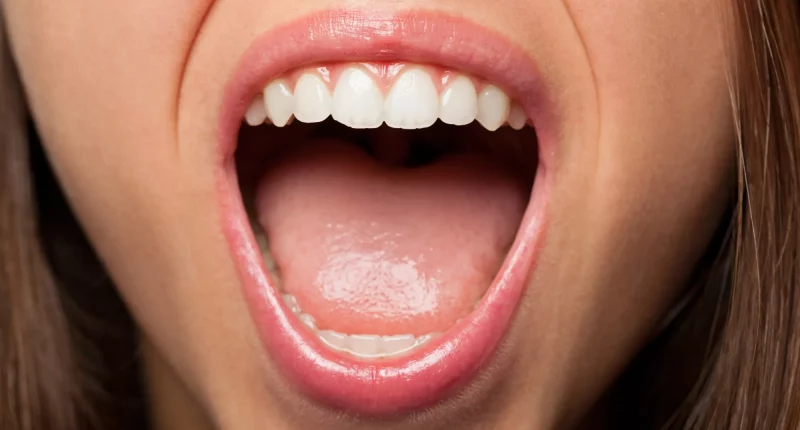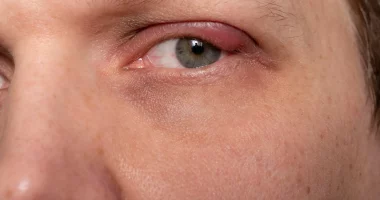Geographic tongue is a condition where smooth, irregular spots or patches are shown on the tongue. These patches make the tongue look like a map, which is why it’s called “geographic tongue.”
The marks form because the tiny bumps that usually cover the tongue, called papillae, are missing in those areas. Although the patches might look unusual, they usually don’t cause pain.
Often, the smooth spots heal in one part of the tongue but then show up in another area. Sometimes, these patches can even show in other parts of the mouth.
It is more likely to affect adulthood individuals. It’s a rare condition, and doctors don’t know exactly what causes it.
Symptoms
Geographic tongue is a condition that may go unnoticed for months or even years. Often, it is discovered by a dentist or healthcare provider during a regular oral test.
This condition is characterized by smooth, irregular, and red patches on the tongue. These patches can appear in more than one part and are often surrounded by an elevated border that may be in white. The patches vary in size and shape and tend to grow, heal, and move to different areas of the tongue in time. They can change in size and may last up to 12 months in one spot before moving.
In addition to the visual changes, geographic tongue can cause mild pain, especially when the tongue comes into contact with certain foods or substances. A few common triggers for this discomfort include cigarette smoking, chewing tobacco, acidic or spicy foods, hot foods, mouthwash, and toothpaste.
Is Geographic Tongue Dangerous?
In spite of its looks, geographic tongue is a harmless condition. While some individuals may feel pain, discomfort, or a burning sensation, these symptoms are usually triggered by contact with acidic or spicy foods.
Geographic tongue is not linked to any type of cancer. However, it may sometimes be associated with other conditions such as psoriasis, celiac disease, and atopic dermatitis (eczema). Although these conditions can occur alongside geographic tongue, there is no evidence to suggest that they cause it.
Although the geographic tongue is usually harmless, the other conditions linked to it might need to be checked or treated by a healthcare provider.
Causes
The exact cause of geographic tongue is currently unknown. However, there is proof recommending that genetics may play a role. If someone in your family has a geographic tongue, you are more likely to develop the condition.
Geographic tongue often happens with a fissured tongue, a condition known to have a genetic connection.
Research states that geographic tongue may be associated with various other conditions, including allergies, psoriasis, asthma, atopic dermatitis, celiac disease, Down syndrome, nutritional deficiencies, Reiter’s syndrome, emotional stress, hormonal imbalances, and type 1 diabetes. Even though there are connections to these conditions, none of them have been proven to cause geographic tongue, and the proof is still restricted. More investigation is required to understand any potential connections.
Because of unknown causes, there is no known way to prevent geographic tongue.
Treatment
In most cases, geographic tongue heals on its own without medical treatment. Individuals who are unaware they have the condition may never seek treatment and might not experience any irritating symptoms.
Even post-treatment, the signs of the geographic tongue can return over time. Available treatments include antihistamine and anesthetic mouthwash, oral painkillers, corticosteroid rinses or topical creams, and zinc and vitamin B supplements.
However, these treatments are not well investigated, and it can be difficult to determine their effectiveness since geographic tongue often resolves without any intervention.
Complications
Geographic tongue does not cause any serious health problems. It is not linked to any cancers or illnesses.
However, its unusual appearance can cause some individuals to feel anxious or stressed. They might worry about what others think of their tongue or fear that it indicates a more serious health issue. This anxiety can lead to psychological discomfort, even though the condition itself is harmless.
When to consult a Healthcare provider
If you notice smooth, red spots on your tongue, it’s a good idea to talk to a healthcare provider or dentist. While geographic tongue is usually harmless, some more severe conditions can look similar to it.
There is some evidence that geographic tongue might be linked to other health issues, like psoriasis. A healthcare provider can help determine if you have a geographic tongue or another condition and provide a proper diagnosis.
If you experience pain or a burning sensation along with the patches, it’s important to see a doctor for advice and possible treatment.
Diagnosing
A healthcare provider or dentist can determine geographic tongue by examining your mouth and tongue. They will:
- Look closely at your tongue to see if there are any unusual patches or signs of illness.
- Shine a light on your tongue to get a better look.
- Gently touch your tongue to identify any uncommon texture or tenderness.
- Ask you to move your tongue to investigate it from different angles.
If the doctor suspects that it might not be a geographic tongue, they may recommend further tests to make sure of the diagnosis.
Outlook
If you have a geographic tongue, you can expect to live a normal life.
The main concerns are usually how your tongue looks and any mild discomfort you might feel. In many cases, the patches on the tongue go away on their own without needing any treatment.
There are no special changes you need to make to your lifestyle because there’s nothing that can stop the geographic tongue from coming back. However, you might want to avoid foods that are spicy or acidic, as these can sometimes cause discomfort.
Summary
Geographic tongue is a harmless condition where smooth, irregular patches appear on the tongue, resembling a map. It often clears up on its own without treatment, though symptoms may recur. While it’s not linked to cancer or serious illnesses, it can cause anxiety due to its appearance.
Diagnosis is typically done through a simple examination by a doctor or dentist, who may conduct further tests if needed. Treatment options include mouthwashes, pain relievers, and supplements, but their effectiveness is uncertain. People experiencing pain or burning should consult a doctor, and although there’s no proven prevention, avoiding certain foods may help manage discomfort.








